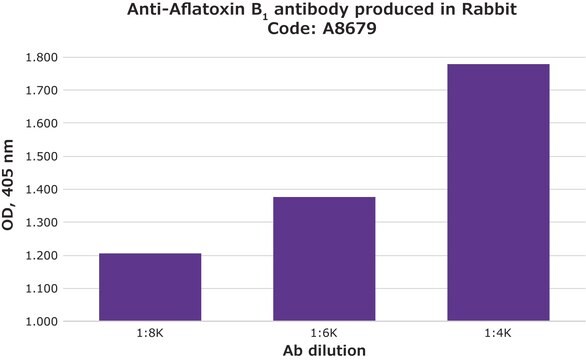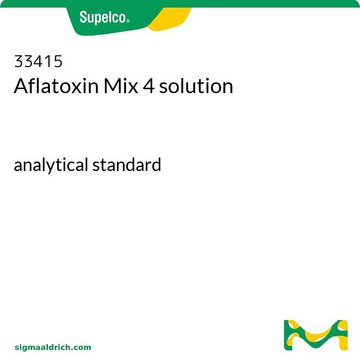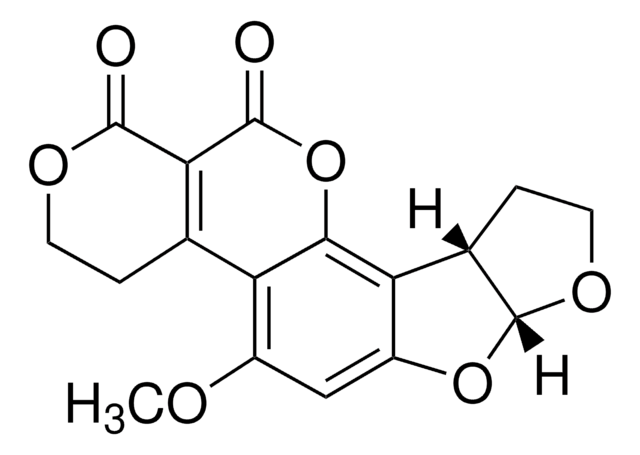A9555
Monoclonal Anti-Aflatoxin B1 (G1, Q1, B2, G2) antibody produced in mouse
clone AT-B1, ascites fluid
Autenticatiper visualizzare i prezzi riservati alla tua organizzazione & contrattuali
About This Item
Prodotti consigliati
Origine biologica
mouse
Livello qualitativo
Coniugato
unconjugated
Forma dell’anticorpo
ascites fluid
Tipo di anticorpo
primary antibodies
Clone
AT-B1, monoclonal
contiene
15 mM sodium azide
tecniche
ELISA: 1:20,000 using aflatoxin B1-BSA
Isotipo
IgG1
Condizioni di spedizione
dry ice
Temperatura di conservazione
−20°C
modifica post-traduzionali bersaglio
unmodified
Descrizione generale
Monoclonal anti-Aflatoxin B (mouse IgG1 isotype) is 1 derived from the hybridoma produced by the fusion of mouse myeloma cells and splenocytes from an immunized mouse.Aflatoxins are a group of naturally occurring fungal toxins (mycotoxins) synthesized by Aspergillus flavus and Aspergillus parasiticus. It is found as contaminants in human and animal food such as corn, peanuts, tree nuts, cottonseed, cereal crops, beans, casssava, milo, sorghum, copra, rice, dried fish and beer.
Immunogeno
aflatoxin B -KLH conjugate
Applicazioni
Monoclonal Anti-Aflatoxin B1 (G1, Q1, B2, G2) antibody produced in mouse has been used in indirect enzyme linked immunosorbent assay (ELISA) and fluorescence polarization assay.
Azioni biochim/fisiol
Aflatoxin B (AFB) and its metabolites is known to act as potent carcinogens, mutagens and teratogens, in addition to its toxicity. Aflatoxins have been implicated in human hepatocellular carcinoma, outbreaks of aflatoxicosis, Rey′s syndrome, chronic hepatitis and increased mortality from infection in animal husbandry.
Descrizione del bersaglio
Mycotoxins, a group of chemically diverse secondary fungal metabolites, induce a variety of toxic responses in humans and animals when food and feed containing these compounds are ingested. Rapidly quantitating levels of mycotoxin contamination can help reduce exposure to these toxins.
Esclusione di responsabilità
Unless otherwise stated in our catalog or other company documentation accompanying the product(s), our products are intended for research use only and are not to be used for any other purpose, which includes but is not limited to, unauthorized commercial uses, in vitro diagnostic uses, ex vivo or in vivo therapeutic uses or any type of consumption or application to humans or animals.
Non trovi il prodotto giusto?
Prova il nostro Motore di ricerca dei prodotti.
Codice della classe di stoccaggio
10 - Combustible liquids
Classe di pericolosità dell'acqua (WGK)
WGK 3
Punto d’infiammabilità (°F)
Not applicable
Punto d’infiammabilità (°C)
Not applicable
Scegli una delle versioni più recenti:
Possiedi già questo prodotto?
I documenti relativi ai prodotti acquistati recentemente sono disponibili nell’Archivio dei documenti.
I clienti hanno visto anche
Development of a fluorescence polarization assay for the determination of aflatoxins in grains
Nasir MS and Jolley ME
Journal of Agricultural and Food Chemistry, 50(11), 3116-3121 (2002)
Mycotoxins
Bennett JW, et al.
Clinical Microbiology Reviews, 16(3), 497-497 (2003)
Physicochemical and immunological characterization of chitosan-coated bacteriophage nanoparticles for in vivo mycotoxin modeling
de Andrade CYT, et al.
Carbohydrate Polymers, 185, 63-72 (2018)
Robert J Lee et al.
Scientific reports, 6, 33221-33221 (2016-09-15)
Aflatoxins are mycotoxins secreted by Aspergillus flavus, which can colonize the respiratory tract and cause fungal rhinosinusitis or bronchopulmonary aspergillosis. A. flavus is the second leading cause of invasive aspergillosis worldwide. Because many respiratory pathogens secrete toxins to impair mucociliary
Screening of Lactobacillus casei strains for their ability to bind aflatoxin B1
Hernandez MA, et al.
Food And Chemical Toxicology, 47(6), 1064-1068 (2009)
Il team dei nostri ricercatori vanta grande esperienza in tutte le aree della ricerca quali Life Science, scienza dei materiali, sintesi chimica, cromatografia, discipline analitiche, ecc..
Contatta l'Assistenza Tecnica.








